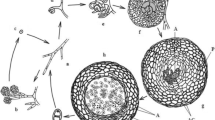Abstract
We revealed differences in lipid and carbohydrate composition between cells of mucorous fungi during endogenous and exogenous dormancy. Endogenous dormancy (zygospores) is characterized by high contents of phosphatidylcholine (about 70% of the total phospholipids) and triacylglycerol (over 90% of the total neutral lipids). By contrast, exogenous dormancy (sporangiospores) is accompanied by elevated amounts of sterols, sterol esters, and free fatty acids, which account for over 70% of the total neutral lipids. We established for the first time significant differences in the phospholipid composition between sporangiospores obtained from stylosporangia and sporangioles. Based on the data obtained, we regard the retardation of life-sustaining activities as a biochemical adaptation based on the dormancy state. We also discuss the taxonomical position of Blakeslea trispora.
Similar content being viewed by others
REFERENCES
Blakeslee, A.F. and Cartledge, J.L., Sexual Dimorphism in Mucorales, Bot. Gaz., 1927, no. 74, pp. 51–53.
Feofilova, E.P., Tereshina, V.M., and Memorskaya, A.S., Hetorothallism in Mucorous Fungi: Physiological and Biochemical Characterization of the (+) and (-) Strains of Blakeslea trispora, Mikrobiologiya, 1997, vol. 66, no.6, pp. 835–839.
Ganger, W.L., The Germination of Zygospores of Rhizopus stolonifer, Am. J. Bot., 1961, vol. 48, no. 5, pp. 427–429.
Feofilova, E.P., Tereshina, V.M., Memorskaya, A.S., and Khokhlova, N.S., Different Mechanisms of the Biochemical Adaptation of Mycelial Fungi to Temperature Stress: Changes in the Cytosol Carbohydrate Composition, Mikrobiologiya, 2000, vol. 69, no. 5, pp. 597–605.
Feofilova, E.P., Tereshina, V.M., Memorskaya, A.S., and Khokhlova, N.S., Different Mechanisms of the Biochemical Adaptation of Mycelial Fungi to Temperature Stress: Changes in the Lipid Composition, Mikrobiologiya, 2000, vol. 69, no. 5, pp. 606–612.
Folch, J., Lees, M., and Sloane-Stanlet, G.H.S., J. Biol. Chem., 1957, vol. 226, no. 1, pp. 497–529.
Kates, M., Techniques of Lipidology. Isolation, Analysis and Identification of Lipids, Amsterdam: Elsevier, 1972. Translated under the title Tekhnika lipidologii, Moscow, Mir, 1975.
Vakulova, L.A., Kuznetsova, V.P., Kolot, F.B., Bab'eva, I.P., and Samokhvalov, G.I., A Rapid Method for Quantitative Determination of β-Carotene in Microorganisms, Mikrobiologiya, 1964, vol. 33, no. 6, p. 1061.
Foppen, F.H., Tables for the Identification of Carotenoid Pigments, Chromatograph. Rev., 1971, vol. 14, pp. 133–298.
Brobst, K.M., in Metody issledovaniya uglevodov (Methods of Carbohydrates Research), Khorlin, F.Ya., Ed., Moscow: Mir, pp. 9–13.
Ashmarin, I.P. and Vorob'ev, A.A., Statisticheskie metody v mikrobiologicheskikh issledovaniyakh (Statistical Methods in Microbiological Investigations), Leningrad: Gos. Izd-vo Med. Lit., 1962.
Feofilova, E.P., Peculiarities of Secondary Metabolism of Microorganisms as Related to the Process of Pigment Formation, Doctoral (Biol.) Dissertation, Moscow: Inst. Microbiol., Acad. Sci. USSR, 1977.
Martin, H.D., Ruck, C., Schmidt, M., Seil, S., and Reutuer, S., et al., Chemistry of Carotenoid Oxidation and Free Radical Reaction, Pure Appl. Chem., 1990, vol. 71, no. 12, pp. 2253–2262.
Zinse, E., Paltauf, F., and Daum, G., Sterol Composition of Yeast Organelle Membrane and Subcellular Distribution of Enzymes Involved in Sterol Metabolism, J. Bacteriol., 1993, vol. 175, pp. 2853–2858.
Van Laere, A.J., Cyclic AMP, Phosphodiesterase, and Spore Activation in Phycomyces blakesleeanus, Experimental. Mycol., 1986, vol. 10, pp. 52–59.
Pisarevskaya, I.V., Changes in the Carbohydrate and Lipid Composition of Absidia coerulea Cell Wall as Related to the Reproduction Process, Cand. Sci. (Biol.) Dissertation, Moscow: Inst. Microbiol., Acad. Sci. USSR, 1985.
Tereshina, V.M., Comparative Study of the Composition and Structure of the Cell Wall of the Fungi of the Family Choanephoraceae during the Process of Differentiation, Cand. Sci. (Biol.) Dissertation, Moscow: Inst. Microbiol., Acad. Sci. USSR, 1983.
Author information
Authors and Affiliations
Rights and permissions
About this article
Cite this article
Tereshina, V.M., Memorskaya, A.S., Kochkina, G.A. et al. Dormant Cells in the Developmental Cycle of Blakeslea trispora: Distinct Patterns of the Lipid and Carbohydrate Composition. Microbiology 71, 684–689 (2002). https://doi.org/10.1023/A:1021432007070
Issue Date:
DOI: https://doi.org/10.1023/A:1021432007070



